Carpenter bees get their name from their habit of drilling wood. Carpenter bees do not eat wood, but will destroy structures by drilling circular holes to create tunnels in the wood.
Unlike other common bees, such as honey bees and bumblebees, which live in colonies, carpenter bees are not gregarious insects and will build their nests outdoors in trees or on the frames, eaves or sides of buildings.

What Does A Carpenter Bee Look Like?
Carpenter bee are similar in appearance to bumblebees, but they do not have yellow markings on their abdomens. In contrast, carpenter bee have smooth and shiny abdomens, while bumblebees have furry yellow abdomens.
The physical characteristics of carpenter bees may vary slightly, as there are seven different types of carpenter bees in the United States and hundreds of species worldwide. Eastern carpenter bees, for example, closely mimic the appearance of bumblebees, with their elongated, black bodies and a patch of yellow hair on their chests. Other species, such as the California honey bee and the female carpenter bee, have more metallic-colored bodies.
How To Identify Carpenter Bees
Carpenter bees look like bumblebees with yellow and black patterns. They are about 1/2 to 1 inch in size and may have some metallic reflections ranging from dark blue, yellow, green or purple shades. Their belly is bare and shiny, unlike bumblebees, which have more hair.
They usually appear in the spring, hovering like a helicopter over eaves, porch railings and below decks. Carpenter bees are sometimes called “wood bees” because they burrow into wood. Carpenter bees do not feed on wood. Carpenter bees use the nectar and pollen of flowering plants as pollinators.
Carpenter bees are not considered true structural pests because they do not spread throughout the structure. They prefer unpainted or untreated wood.
Learn These Basic Things About Carpenter Bees
Habit
Unlike bumblebees, carpenter bees are solitary and do not live in nests or colonies. Adult carpenter bees overwinter in abandoned nest tunnels, where they have limited pollen stores to survive in cooler temperatures. Bees that survive the winter hatch in the spring, feed on nectar, mate and build galleries.
Female carpenter bees chew through circular holes in the wood, creating separate corridors to lay eggs and protect the larvae as they develop. They particularly tend to build galleries from soft, unpainted, and worn woods, although some species prefer hardwoods. Wooden structures on the property, such as decks and fences. New galleries average 10-15 inches long, but reused galleries can extend up to 10 feet. When the female tunnels, she burrows into larger open areas in the tunnel, called cells, where her pups will develop. She supplies each gallery cell with plenty of pollen and regurgitation of nectar, on which she lays an egg.
The female then seals this part of the gallery with chewed wood pulp. Eggs laid by females take about 36 days to develop into adults.
Do Carpenter Bees Sting?
Male carpenter bees do not sting, but they are territorial and oftentimes the gender that most people come into contact. Males will hover close to humans, especially interested in sudden movements, but only cause undue fear. Female carpenter bee stings; however, this occurs on rare occasions and requires provocation.
Nuisance and Damage
Although carpenter bees are rarely as destructive as termites, they can cause cosmetic and structural damage. Female carpenter bees dig new tunnels in the wood to lay their eggs, or expand and reuse old tunnels. Infesting the same blocks year after year can cause significant damage. Holes in the wood surface also facilitate the entry of moisture, rot and rot.
How to get Rid of Carpenter Bees Naturally
Don’t like using pesticides or toxic chemicals to eliminate carpenter bees? Neither do we!
Fall Prep to Deter Carpenter Bees
Seal any wood turf or pre-existing holes in the wood. Each spring, when female carpenter bees start looking for a new home, they look for imperfections in the wood as ideal places to nest. Use wood filler in the fall to cover up holes and cracks to make your home less attractive in the spring.
Repair damage to old wooden beehives. Autumn is the best time to prepare for carpenter bees. The adults are dead, and the larvae and larvae overwinter in the tunnels, making autumn the safest time to attack existing nests. Pour in almond oil or place a cotton ball soaked in rubbing alcohol into the nest. Then seal the entry hole with steel wool, wooden dowels, and a wooden spatula.
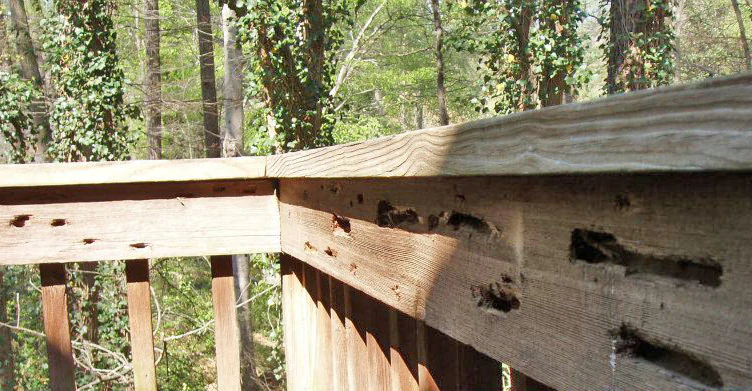
Catch the Carpenter Bees Without Chemicals!
Place wood bee traps every spring! Traps are a good deterrent even if you don’t have an active wood hive. The traps will attract any carpenter bees exploring the area before they get a chance to nest. This is the best way to use carpenter traps. Each trap has a working radius of 15 feet, so plan accordingly!
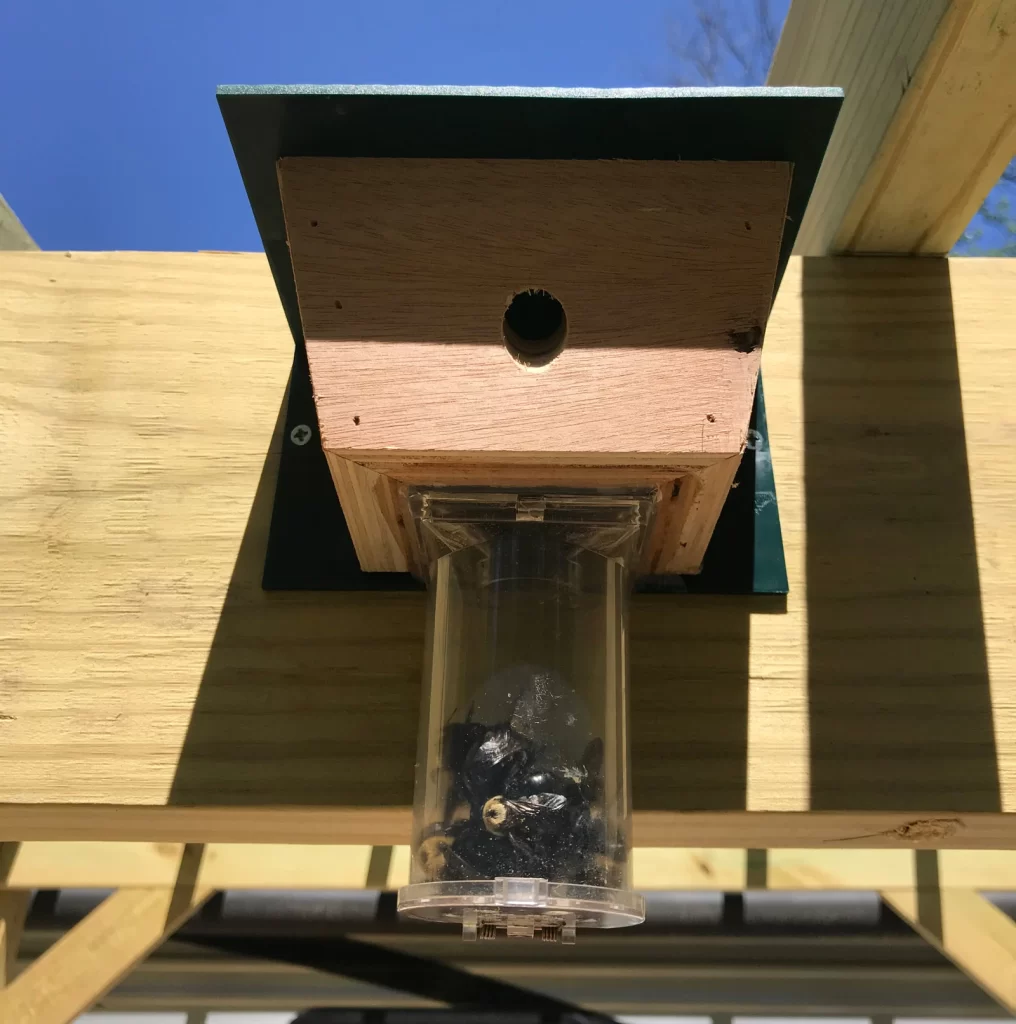
Round Natural Carpenter Bee Removal
Use a citrus spray to protect the wood. Citrus smells are very distasteful to carpenter bees. You can make your own citrus spray by boiling citrus peels in water for a few hours and draining them into a squeeze bottle. Or you can buy a citrus spray. Depending on the weather, spray the wood every few days to protect it. This method is great for patio and porch furniture and playsets.
Use almond oil. Applied to wood, almond oil has an insect-repellent effect similar to a citrus spray. Carpenter bees hate the smell and it will prevent them from nesting in the sprayed wood. Some were also lucky enough to spray new nest openings with almond oil to encourage existing carpenter bees to leave. Mix almond oil with water and spray it on wood, or apply the oil directly to carpenter bee nests.

Treat your wood with borates! Borate wood treatment for finished and unfinished wood. While this solution isn’t technically chemical-free, it’s a great way to protect wood and keep wood-boring insects of any kind from entering your home.
Vacuum carpenter bees away. If you have a powerful enough vacuum and a small attachment, you might be able to suck carpenter bees out of their nests. This method works best when the nest is new and not very deep. Vacuuming won’t get larvae, so properly seal the nest after removing the adults.
Play loud music! Some people have found that playing loud music next to an active nest causes carpenter bees to venture out, at least for a short period of time. This method can work because wood bees are sensitive to noise and are uncomfortable with the vibrations of music. This gives you a chance to repair the nest before the adults return. Once the nest is sealed, be sure to set up carpenter bee traps to catch escaped adult carpenter bees!
Sprinkle diatomaceous earth on the nest to kill larvae and bees. Diatomaceous earth is the fossilized remains of diatoms (algae). Made up of microbes that can destroy the exoskeleton of any pest it comes in contact with, it has long been used as a natural pest control agent. Wear gloves, a mask, and long sleeves when applying diatomaceous earth to the nest, as contact with bare skin may cause a rash. Remember to seal the nest after handling.
Naturally repelling carpenter bees is not difficult if you have the right tools. Preparing your home in the fall and carpenter bee traps in the spring will ensure adequate protection.
Carpenter Bees vs. Honey Bees
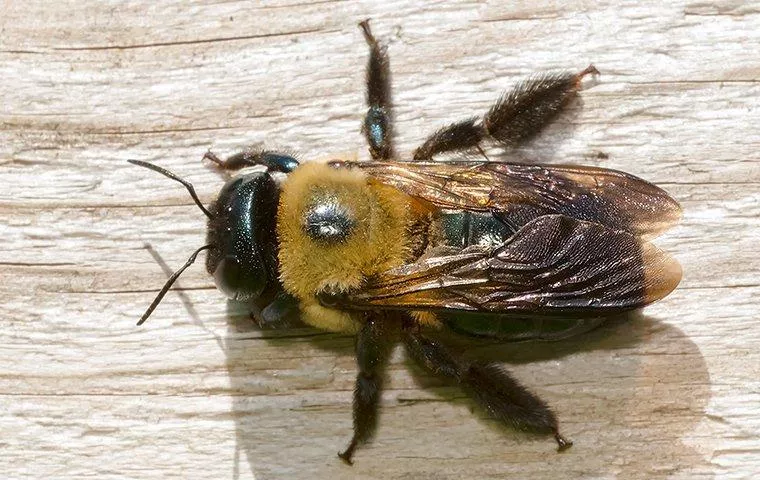
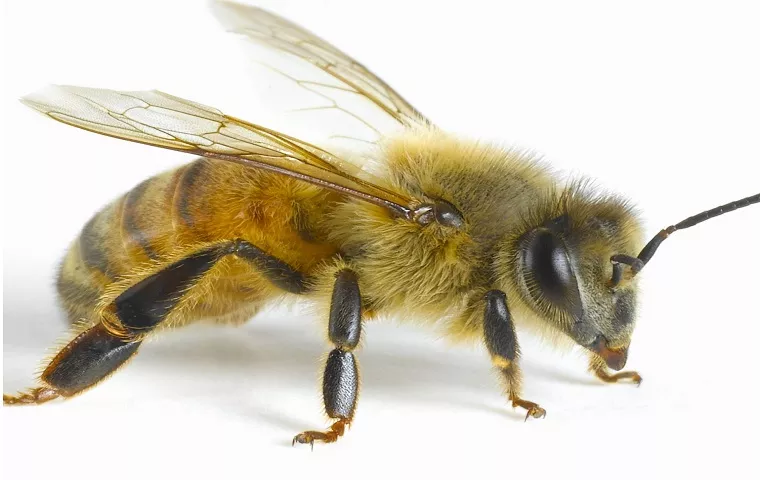
Almost everyone in biology class learns that bees are an important part of our ecosystem and pollinate flowers and plants on a busy flight. On the other hand, few of us know how to distinguish these beneficial insects from their harmful cousins, the carpenter bee.
The first difference between these bees is where they live. Bees live in outer hives (or special dwellings for beekeepers), while carpenter bees live in trees and wooden structures. They prefer unpainted, protected wood surfaces. This is the main reason why these bees are so annoying. Not only do they build huge colonies, but their presence can cause significant damage to the wood and structures they inhabit. Instead of eating wood, they destroy it by drilling large tunnels to house their offspring.
Externally, the carpenter bee is similar to the bumblebee except for its glossy black, hairless abdomen. Honey bees look different, with small bodies, hairy trunks and thin wings. Both bees were observed looking for plants to collect nectar and pollen from.
People’s first concern is being stung by any kind of bee. Common bees are at little risk unless they accidentally tip over the hive or engage in aggressive behavior. Bees can only sting once, and only female bees can sting. The same goes for carpenter bees. Only females have the ability to sting, and they rarely bother humans. However, males are often attracted to movement and will hover near moving hands.
Carpenter Bees vs. Bumblebees
Carpenter bees are similar to bumblebees, but usually have shiny, hairless abdomens. (Bumblebees typically have hairy abdomens with black and yellow stripes.) Bees also have different nesting habits—hornets usually nest in existing cavities in the ground (such as abandoned rodent burrows), while carpenter bees typically build their nests in existing cavities in the ground.

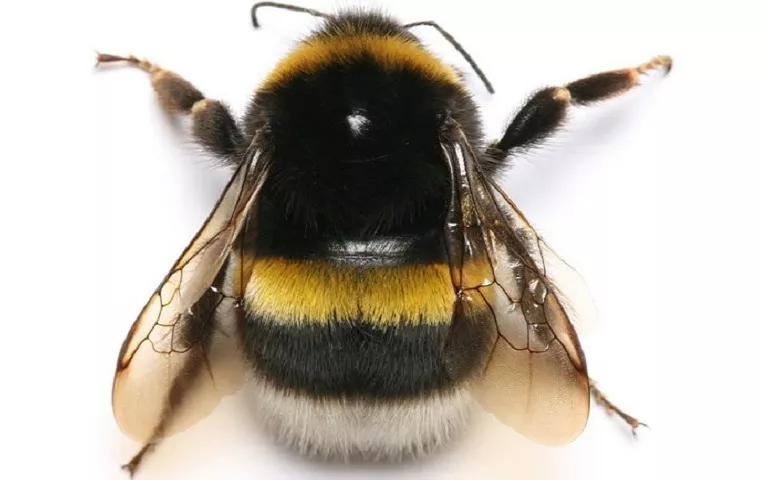
Carpenter Bees
Size: 1/4″ to 1″
Color: The wood bee has a metallic blue-black, green, or purple luster, with a glossy abdomen and relatively hairless.
Nests: Carpenter bees burrow into exposed wood to build their nests. Carpenter bees get their name from their ability to pierce and build nests in wood. Your drill will create a near-perfect hole about 1/2 inch in diameter. You’ll see round holes and a rough sawdust-like substance called chips below the holes. The holes are perfectly circular, about 3/8″ in diameter. You may find the old hole near the new hole. Carpenter bees can use old nests year after year. Their holes are usually found on the underside of any wood surface, including siding, soffits, overhangs, decks, fence posts, lintels, and window frames.
Other signs are brown or yellow fecal stains below the gallery entrance.
Carpenter bees are solitary bees: carpenter bees do not form swarms, live alone, and rarely sting. Every woman is fertile. They look for or make holes in cells to lay eggs. Once the baby carpenter bee food is stored, they will seal the cells. Females do not return to sealed cells. Solitary bees include carpenter bees, leaf pickers, leaf cutters and diggers. Solitary bees pollinate plants more efficiently than gregarious bees.
Carpenter bee stings: Because carpenter bees are solitary bees, they don’t sting as often. Female carpenter bees sting if provoked.
Bumblebees
Size: 3/4″ to 1″
Color: Bumblebees are shaggy with a fluffy abdomen and most of their body is covered in soft, fluffy hair. They have contrasting black and yellow bands.
Nests: Bumblebees usually burrow into the ground. They can take advantage of abandoned rodent burrows and voids under patio stones, compost piles and landscaping wood.
They may nest on the ground or in structural cavities in exterior walls or attic soffits. They don’t usually nest in structures like carpenter bees.
Bumblebees are gregarious bees: Bumblebees live in beehives, where they produce honey and wax. When the hive is in danger, they sting, but mostly ignore humans.
The Queen is the only woman who can have children. The hive is ruled by and dependent on the queen.
Other Facts About Carpenter Bees
1. Carpenter bees do not live in colonies like bees or bumblebees.
2. The entry hole in the wood surface is perfectly circular, about the diameter of your pinky finger
3. They dig new tunnels in the wood for spawning, or expand and reuse old tunnels
4. Carpenter bees live on every continent except Antarctica.
5. Carpenter bees are often confused with bumblebees and are distinguished by their shiny black tails. Wasps also look like wood wasps, but with smaller waists.
6. Carpenter bees are not active throughout the year. They hibernate in winter,
5. Females do sting, but rarely.
6. They sting if caught or crushed. Carpenter bees have no barbs on their stingers, so they can sting again and again.
7. The tunnel is built with the strong jaw of the carpenter bee as it vibrates itself in the wood.
8. Instead of eating wood, bees repurpose the particles to build individual cells or discard them.
9. Female carpenter bees can only inflict painful stings if touched or harassed by humans.
10. They prefer unpainted weathered wood
Source:
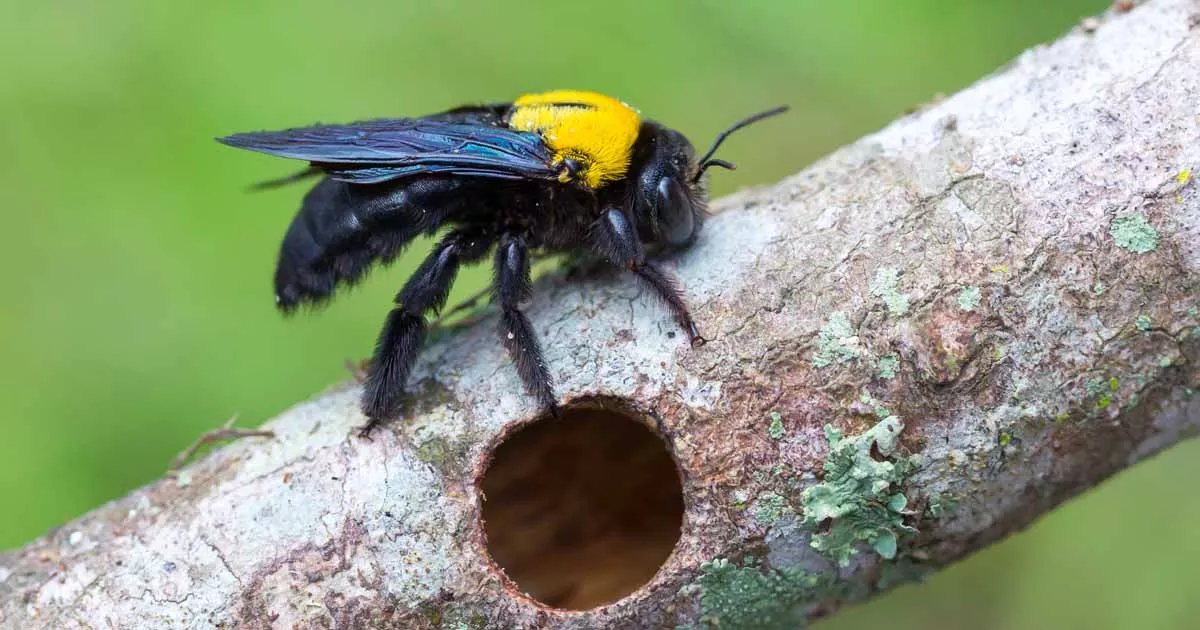
Leave a Reply
You must be logged in to post a comment.